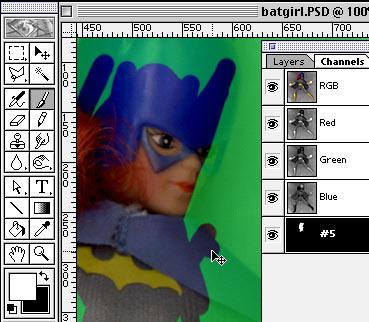- The new channel turns the whole thing black?
Yes, but don't worry. That is simply the MASK.
-
- Turning on the new channel and the RGB channel turns the mask into
a transparent color overlay. Notice that the COLOR SWATCHES on the toolbar
have switched to black and white. This is because channels operate on a
black to white scale. When the channel is finally converted to a selection
the white parts will be active
and the black parts will be masked
out. Of course, since we are also viewing the RGB Channel, the black
part of the mask is colored, the white part is transparent.

- So now we take the BRUSH and paint on the mask with white. You can
also INVERT the channel so the mask is white and then paint with black.
That's your choice whether to paint ON or paint OUT the mask.
Here I am painting over the figure with the white. The goal is to paint
a perfect silhouette over the figure. This is superior to say, erasing
on the actual layer because you are not affecting the actual image yet.
You are simply painting the mask. When the white has gone past where you
want it, as it is above on her cape, just switch over and paint with black
until you have that edge where you want it.
-
- Note: The word INVERT is used in two different ways in Photoshop. INVERT
occurs in the IMAGE/ ADJUST menu and it inverts the color and value. INVERT
SELECTION is in the Selection Menu and it is used when you select something
(with the Lasso For example) and want to work on everything outside of
the selection you drew. Okay? Okay. Technical writing perhaps isn't my
strong suit. Perhaps that's a good thing.
-
- This is working fairly well to block out the shape, and the organic-type
lines of the cloth are fairly forgiving, but what about a nice hard
edge on that helmet? That's hard enough to do with a drawing tablet!
It's almost impossible with the mouse.
NEXT
